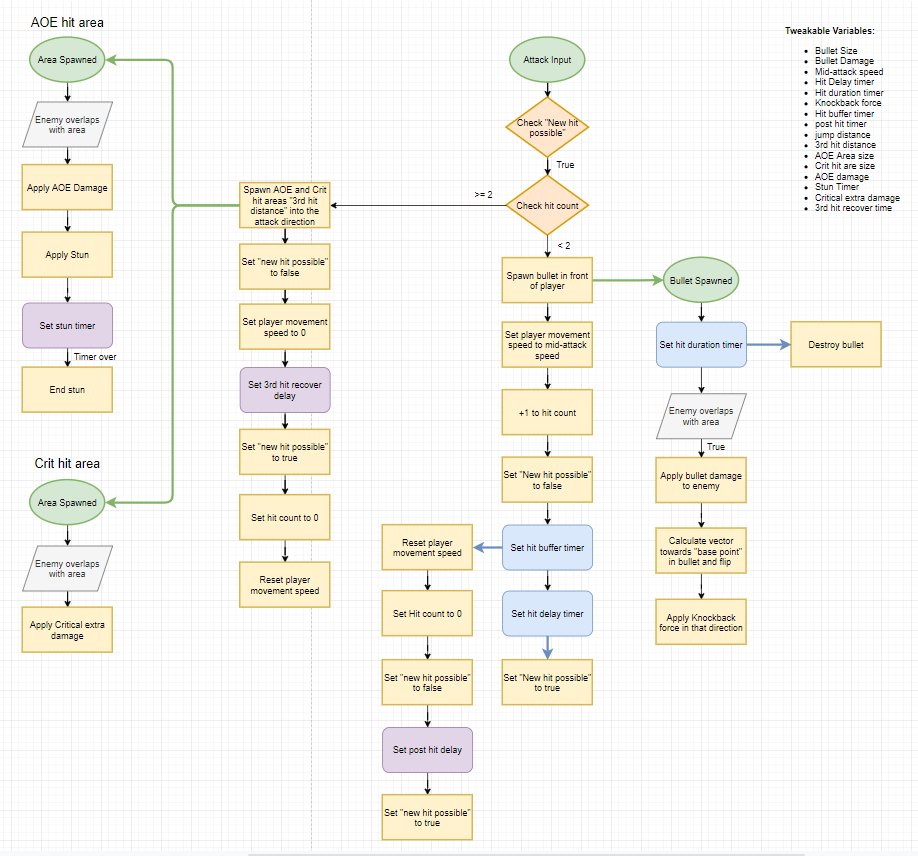
Twin Stick Jukebox
The Twin Stick Jukebox was a collaborative project between several groups of developers: each would develop a different game mode for a twin stick shooter that would be part of a collection of game modes, the so-called “Twin Stick Jukebox”
Our project group collaboratively designed the payload style game mode, while my responsiblitiy was the design and implementation of a unique weapon and enemy, as well as auxillary functionality like the barrier dash and weapon system.
4 Devs
8 Weeks
Twin-Stick Shooter
Unreal Engine 4
PC
University Project
Concepting
Each of the developed features, from the weapon and enemy to the barrier dash and weapon system, started out with extensive ideation through sketching. These sketches were then used as the baseline for the next steps in development.
Feature Breakdowns
The implementation phase of the each of the features started with the creation of a detailed feature breakdown graph. With the help of these breakdowns, the features were then implemented using various different techniques.
Implementation
Making use of the feature breakdowns I created previously, I would implement the features step by step. Using playtesting data and our QA pipeline, I was able to improve each feature bit by bit until the end of the project.
Sketching & Concepting
In this project, we each individually needed to design and implement one weapon and enemy, as well as collaboratively create a game with a unique player ability.
To start off, I created a wide variety of rough sketches for a potential weapon, enemy and player ability. These sketches were based on competitor and reference game research and, over time, further explored and refined, until I landed on the final enemy and weapon design, as well as the player ability we chose to use.
For the pitch presentation we needed to prepare for the end of the concepting phase, I created cleaner versions of the sketches for the chosen features, which helped us secure the green light.
Feature Breakdowns
Once the feature design was locked in place, I started creating feature breakdowns. Besides the weapon and enemy I needed to work on individually, I also took on the responsibility for a barrier dash (the player ability we chose to implement) and a weapon inventory system.
The main part of these feature breakdowns were functionality flow charts. Here I would break down the functionality of each feature as much as possible, so that I could use them to make the implemetation process as quick and easy as possible.
Implementation
Once the features were sketched out and concepted, the concept was greenlit and the freature breakdowns were ready to be used, I started implementing them. In total, the features I implemented were the weapon inventory system, allowing players to pick up up to 2 weapons from random enemy drops and freely switch between them, the barrier dash ability, which would allow the player to dash into one direction, leaving behind a barrier that would block all enemy projectiles, and my personally developed enemy and weapon.
Below you can see the end result of the latter two. The hammer weapon gave the player access to a short-ranged 3 hit AOE combo with a powerful critical hit and stun effect on the final hit. The enemy was the artillery, shooting bombs at the player’s location from range and exploding for massive damage if the player would come too close. Over time, thanks to regular playtesting and a team-wide QA pipeline, I was able to and adjust and improve all my implemented features, including implementing visual effects such as screenshake and sound effects.








